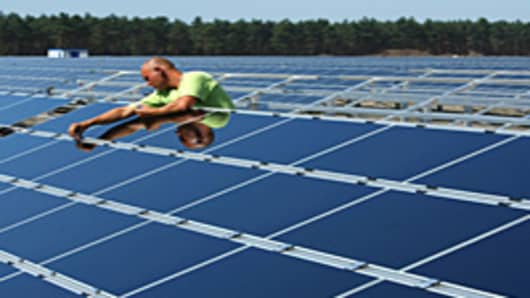The Obama administration may be tempted to wage a two-front war on climate change and joblessness by pushing for green jobs in the renewable energy sector, but such a strategy will mean committing to a long campaign.
Looking for the green equivalent of an atomic bomb to obliterate ten percent unemployment, energy price volatility and carbon emissions all at once may not be the right approach, says Jesse Jenkins, director of energy and climate policy at The Breakthrough Institute, a clean energy research group.
“This looks more like the Cold War than the Manhattan Project,” says Jenkins. “There are no short-term solutions to real problems.”
Jenkins and others in the renewable energy sector see the need for the right mix of long-term technology investment—in a sector where installed power generation capacity and electricity contracts are measured in decades—and short-term job creation to keep the issue at the top of the public's mind.
On Jan. 8, President Obama announced $2.3 billion in tax credits for 183 different firms working on new energy storage and other renewable energy technologies, claiming the investment would create 17,000 American jobs.
But while new technologies are great, the national energy infrastructure needs replacing and getting that done with the necessary scale will require government investment and guidance, says Bob Nelson, a 25-year veteran of the renewable energy sector and co-head of the renewable energy group at law firm Akin Gump.
“We’ve been living off and drawing down our infrastructure investment for the last 30 years,” he says, crediting the “massive government investment” in infrastructure in the 20th century for allowing the US economy to thrive. “We need to invest in a way that can be profitable to government, to companies and to the public.”
In the short term, focusing on energy efficiency retrofitting of existing buildings to save energy and on distributed renewable energy generation—like solar panel installations on warehouses—could help put the hard-hit construction industry back to work.
“That may mean jobs somewhere down the road but we need jobs now,” says Barry Yerger Jr., CEO of Mid-Atlantic Renewable Partners, a Wilmington, Del.- based fund focused on smaller scale renewable energy projects, about the president’s tax credit announcement.
“If the money was earmarked for less R&D and more [efficiency], all of those building trades would benefit,” he says, pointing out that expected government job-creation efforts might get the quickest bang for their buck in energy efficiency. “That money is immediate in the economy.”
“My only worry about it getting in [any proposed] jobs bill is the focus on the speed of job creation,” says Kate Gordon, VP of energy policy with the Center for American Progress, CAP, a progressive think tank, about making green jobs a focus.
“We need to think about this comprehensively," she says. "The jobs created in manufacturing are permanent, whereas those for construction are not."
Gordon says national manufacturing infrastructure is lacking, and that even with the current hype about the sector, renewable energy research is down significantly from where it was during the oil crisis of the ‘70s.
She adds that many of the firms benefiting from Obama’s tax-credit announcement earlier this month are post-pilot and pre-commercialization, known in Silicon Valley venture capital circles as the tech “Valley of Death”—that is, too late for VC funding, but too early to generate significant revenue, and needing capital to begin manufacturing at scale.
As for how much money is needed, The Breakthrough Institute’s Jenkins says the figure of $10 billion per year for ten years is often thrown around, but when compared to the government's annual research spending on health ($30 billion) and defense ($80 billion), it’s small.
“The goal is to build up a flywheel to get momentum,” says Jenkins. “I’d like to see more communication of that from our leaders.”
Given the debate over government involvement in the economy, there’s little appetite on all sides for New Deal-like, taxpayer-only investment.
Suggestions to raise government capital for further green job creation include implementing a strong national version of state-level renewable portfolio standards that mandate renewable energy use by investor-owned utilities like FPL Group and The Southern Company , but these costs will likely be borne by ratepayers.
President Obama suggested last year that he would cut oil sector subsidies, estimated by various sources at between $6 billion to $39 billion annually, which could then be redirected toward renewable energy.
Another idea involves creating a green development bank to backstop private sector loans for renewable energy projects.
The purpose is to compensate for a lack of project financing that has been a bottleneck in the past, but some say with the financial sector in recovery mode it may not be a key component anymore.
“At the beginning of [2009], the debt market was effectively closed and the tax equity [investor] market was down to us and a handful of players,” says Lance Markowitz, head of alternative energy financing unit at California’s Union Bank. “That’s changing. If you have a solid project with proven technologies, unless it’s over $700-800 million, it’s very financeable.”
He adds his bank provided financing for over $3 billion in renewable energy projects in 2009, and that while some deals get held up over arguments on terms and conditions as expected, he says some government subsidies—like Department of Energy loan guarantees—are actually incentivizing project developers to “slow down” to get what they hope will be cheaper financing.
“Clearly the government is a competitor,” he says. “I’m not saying that’s a bad thing: the government is supplying a very large part of the capital needed.”
Markowitz says that if developers look out over the lifetime of their deal, the savings on financing between private and public capital sources will likely be small.
CAP’s Gordon agrees. “Should the government’s role be to finance projects that are commercially viable?” she asks.
While it remains to be seen if the administration’s focus on green jobs gets the right blend of short-term employment and long-term development, Gordon says that the Energy Cold War -- like the old standoff with the Soviet Union of past decades—churns on, even if it’s not in the headlines.
“Without strong demand for these products, and a shift away from the current energy system, we simply won't see the economic growth we need,” she says. “We don't want to be in a situation where, by the time we get around to changing how we generate and use electricity, other countries have invented and marketed all our potential solutions.”



